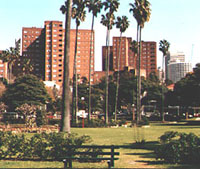PARKS AND GARDENS . . .
She watched new buildings crowd the skies
Office blocks replacing houses
A city growing before her eyes.
© Jim Low - "Miss Carey's Little Park"
![]() listen:
listen:
 Ulleswater overlooks Milson Park. This park holds many memories. Here we played hide and seek, soldiers, cricket, chasings and the like.
Ulleswater overlooks Milson Park. This park holds many memories. Here we played hide and seek, soldiers, cricket, chasings and the like.
Next to the park is a smaller one, Miss Gladys Carey's Reserve. Miss Carey used to live with her older sister in High Street, North Sydney. This was not far from where my family lived. She had come to Australia from England as a child with her family last century. When I first met her in the 1950's she would have been over seventy years old.
During the Second World War, people living in North Sydney were asked by their local council to look after the appearance of their street. Miss Carey acted upon this request, keeping not only the footpath in front of her home tidy, but other neighbours' home fronts as well. Just opposite Miss Carey's house was a walkway down to Milson Park. Part of this walkway included a steep staircase, beside which there was an area of ground that had been left to run wild. Over the next twenty years Miss Carey changed this area into gardens. At the bottom of the staircase she made a park.
I can still remember Miss Carey quite clearly. Weather didn't stop her gardening and she could be seen toiling away on the most miserable of days. All the plants she grew came from cuttings from her own garden, her neighbours' and even those which people had thrown in the street. The stones that formed the rockeries were manoeuvred into place by her.
When I was a child, bread was delivered to homes in our district by horse and cart. The baker's cart would stop each day opposite Ulleswater where I lived. At my mother's suggestion, I would shovel up the horse manure that was left most days on the side of the road after the baker's visit. With my bucket of hot manure, I would then walk the short distance to Miss Carey's park and leave the contents there. She was a very friendly old lady and most thankful for the manure. I remember once, after she had tended her gardens and rockeries, that she went home and returned with some slides and a viewer. Seating herself in Milson Park, she proceeded to show my friends and me slides of far off places she had visited.
In 1967 the local council recognised the work of Miss Carey by naming this area after her. Whenever I return to North Sydney I try to make time to visit her park and happily spend some time remembering this wonderful old lady who believed in the value of living a useful life.
Nowadays when I return to North Sydney, I deliberately travel the district by foot, the way I did as a child. Walking allows me the opportunity to observe that finer detail noticed as an inquisitive child. I've also found that walking unclutters the mind of a lot of excess baggage the years have thrown on board, allowing my memory to function more effectively.
The experience of roaming this environment, which I knew intimately as a child, is similar to looking at a photograph that's been double-exposed. Layered below the scenes confronting me now are the old images from childhood memory. The people and places from the North Sydney I knew as a child, now appear in the songs and stories I have written, another way of documenting my childhood memories.



